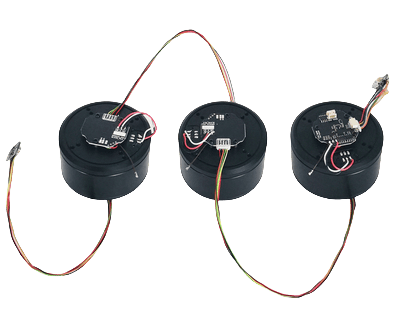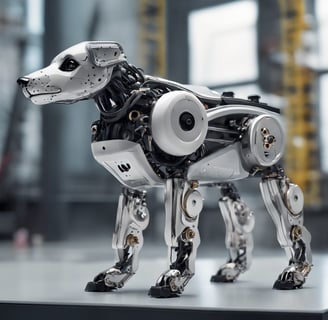Exploring Different Types of Robot Motors: DD, DC, and Beyond


Introduction: The Pulse of Modern Robotics
Imagine a factory floor where precision is paramount, where robots move with seamless accuracy, assembling complex products with zero tolerance for error. The secret behind this flawless performance lies in the heart of these robots—their motors. For robotics engineers and project managers, selecting the right motor can make the difference between a groundbreaking innovation and a costly misstep. In this article, we’ll explore the various types of robot motors—focusing on Direct Drive (DD) and DC motors—unpacking their unique benefits, applications, and how they are revolutionizing the field of robotics.
The global robotics market, projected to grow from USD 39.3 billion in 2020 to USD 73.0 billion by 2026 at a CAGR of 10.5%, underscores the critical importance of choosing the right motor to stay ahead in this rapidly advancing industry .
Understanding the Motor Landscape
Robot motors come in various shapes and sizes, each with its own set of strengths. The most common types include DD motors, DC motors, stepper motors, and servo motors. Each motor type plays a critical role in robotics, depending on the application, desired precision, and performance requirements.
1. Direct Drive (DD) Motors
DD motors are becoming increasingly popular in high-precision applications, particularly in robotics where accuracy and smooth operation are critical. These motors eliminate the need for mechanical transmission components like gears or belts, resulting in minimal backlash and higher efficiency. This direct connection between the motor and the load not only reduces maintenance but also enhances responsiveness and precision.
As the global direct drive motor market is projected to reach USD 6.8 billion by 2025, growing at a CAGR of 6.7%, it’s clear that the demand for motors offering superior precision and reliability is on the rise .
Performance and Applications:
Performance: DD motors offer high torque at low speeds, making them ideal for tasks that require fine control and precision.
Applications: Commonly used in robotic arms, CNC machines, and other applications where precision motion is essential.
Moreover, DD motors can achieve positioning accuracy of up to 0.5 arcseconds, significantly outperforming traditional geared systems, which makes them indispensable in scenarios demanding exact precision .


2. DC Motors
DC motors are perhaps the most widely used in robotics due to their simplicity, reliability, and cost-effectiveness. These motors convert electrical energy into mechanical motion through the interaction of magnetic fields, offering variable speed control with ease.
Performance and Applications:
Performance: DC motors are known for their high speed and torque, making them versatile across a wide range of robotic applications.
Applications: From simple mobile robots to complex robotic systems in industrial automation, DC motors are the workhorses of the industry.
The widespread adoption of industrial robots, which reached a new record of 384,000 units globally in 2020, highlights the pivotal role that reliable and versatile DC motors play in automation . However, while DC motors offer flexibility, they may not match the precision and efficiency provided by DD motors in high-end applications.
3. Beyond DD and DC: Other Motor Types
Stepper Motors: Ideal for applications requiring precise control of rotational position without the need for feedback systems. Often found in 3D printers and CNC machines.
Servo Motors: Known for high accuracy and speed, servo motors are used in advanced robotics where precise positioning and motion control are required.


The Future of Robotics: Choosing the Right Motor
As robotics continues to evolve, the choice of motor becomes increasingly critical. While DC motors provide versatility and cost-effectiveness, DD motors are pushing the boundaries of precision and efficiency in advanced applications. Robotics engineers and project managers must consider factors such as torque, speed, precision, and application-specific requirements when selecting the appropriate motor.
The growing demand for industrial automation, projected to grow at a CAGR of 8.2% from 2021 to 2028, further emphasizes the importance of selecting motors that deliver both performance and efficiency in automated systems .
TurboFlys DD Motor and Robotic Motor: For those in search of cutting-edge performance, TurboFlys offers a range of DD motors and robotic motors designed to meet the demands of modern robotics. These motors exemplify the advancements in motor technology, providing the precision and reliability necessary for high-stakes applications.
Conclusion: Driving the Future of Robotics
The choice between DD motors, DC motors, and other motor types is not just a technical decision—it’s a strategic one. As the robotics industry grows, the need for motors that can deliver precision, efficiency, and reliability is more important than ever. By understanding the strengths and applications of each motor type, robotics engineers and project managers can make informed decisions that drive innovation and success in their projects.
TurboFlys stands ready to support these innovations with state-of-the-art motors that are built for the future. Whether you’re developing a new robotic system or optimizing an existing one, the right motor will be the pulse that powers your success.
